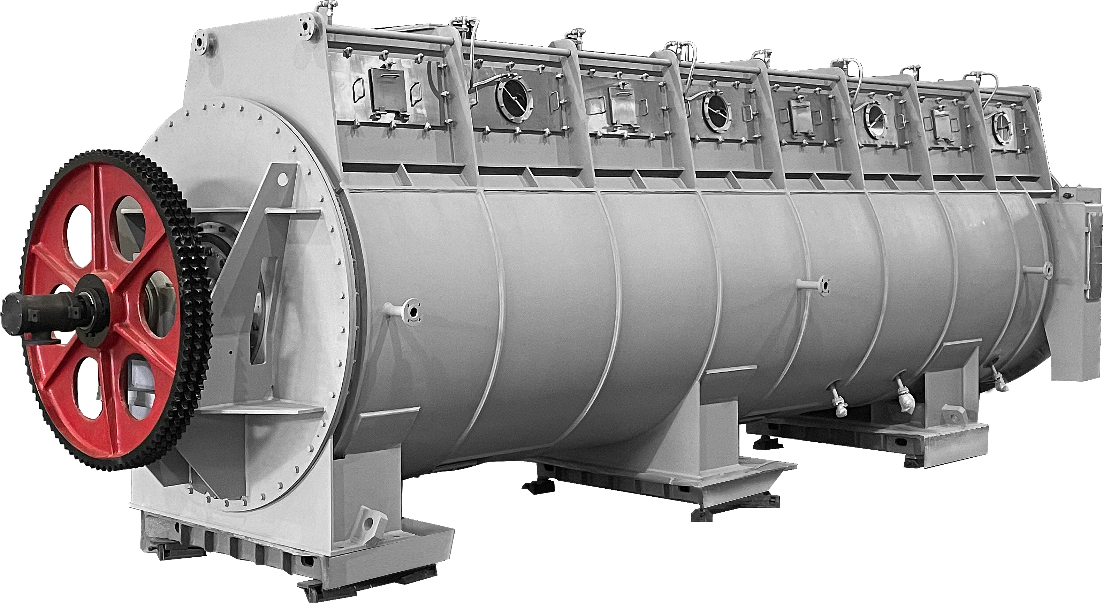

BLOG
What is blade drying machine?
What is blade drying machine?
08 September 2023
Blade drying machine (known as blade paddle dryer or screw sludge dehydrator) is an industrial drying system used to remove moisture or solvents from various materials such as sludge (municipal, printing and dyeing, chemical industry, paper making, hazardous waste sludge, etc.) , gypsum, kitchen biogas residue, coal sludge, fish meal, aluminum hydroxide, pharmaceutical residue, wine residue, food, fertilizer, resin and other materials. It is characterized by a unique design featuring hollow, heated paddles or blades that mix and agitate the material while it is being dried. The primary purpose of a blade paddle dryer is to efficiently and evenly dry or heat-treat substances.

Blade drying machine consists of several key components that work together to facilitate the drying process and ensure efficient operation.
The main components typically include:
1. Cylindrical Vessel: The main body of the dryer is a cylindrical vessel or chamber where the material to be dried is placed. It is usually made of stainless steel or another corrosion-resistant material to withstand the drying conditions.
2. Rotating Blades or Paddles: Inside the cylindrical vessel, there are rotating blades or paddles. These are responsible for both mixing and heat transfer. The blades are designed to agitate and move the material while also coming into direct contact with the heated surfaces, promoting efficient drying.
3. Heating System: Blade paddle dryers have a heating system that provides the necessary heat for the drying process. This can include steam jackets on the vessel walls, electric heating elements, or other heating mechanisms.
4. Cooling System (Optional): In some applications, a cooling system may be integrated into the dryer to cool the material down after drying or heat-treatment.
5. Drive System: A motor and drive mechanism are used to rotate the blades or paddles within the vessel. This drive system controls the speed and direction of rotation.
6. Inlet and Outlet Ports: The dryer has ports for material entry and exit. The material to be dried is typically introduced through an inlet port, and the dried or processed material is discharged through an outlet port.
7. Seals and Gaskets: To ensure airtight or vacuum operation (if required), blade paddle dryers use seals and gaskets to prevent leaks and maintain the desired operating conditions.
8. Control System: Modern blade paddle dryers are equipped with control systems that allow for precise regulation of parameters such as temperature, rotation speed, and drying time. This ensures efficient and consistent drying.
9. Dust Collection System (Optional): Depending on the application and the material being processed, a dust collection system may be incorporated to capture and contain any dust or emissions generated during the drying process.
10. Safety Features: Blade paddle dryers are equipped with safety features such as pressure relief valves, temperature sensors, and emergency shutdown systems to ensure safe operation.
Blade drying machine offer several advantages in various industrial drying applications due to their unique design and capabilities.
The key advantages of blade paddle dryers include:
1. Gentle Drying: Blade paddle dryers provide gentle drying and mixing, making them suitable for heat-sensitive materials and products that can be easily damaged by more aggressive drying methods.
2. Efficient Heat Transfer: The direct contact between the heated blades or paddles and the material ensures efficient and uniform heat transfer, leading to faster drying times and energy savings.
3. Uniform Drying: The mixing action of the rotating blades ensures that the entire batch of material is exposed to the same drying conditions, resulting in consistent and uniform drying.
4. Versatility: Blade paddle dryers are versatile and can handle a wide range of materials, including chemicals, pharmaceuticals, food products, slurry, and more. They can be used for drying, cooling, and heat-treatment processes.
5. Reduced Product Degradation: The gentle mixing and drying process help minimize product degradation and maintain the quality of the material being processed.
6. Dust Containment: Blade paddle dryers are effective at containing dust and emissions, making them suitable for materials that require a controlled environment or have strict environmental regulations.
7. High Throughput: These dryers are capable of handling large batches of material, making them suitable for industrial-scale production.
8. Precise Control: Modern blade paddle dryers are equipped with advanced control systems that allow for precise control over temperature, rotation speed, and other drying parameters, ensuring consistent results.
9. Reduced Operator Interaction: Once the parameters are set, blade paddle dryers often require minimal operator intervention, reducing labor requirements.
10. Hygienic Design: Blade paddle dryers can be designed with sanitary features, making them suitable for food and pharmaceutical applications where cleanliness and hygiene are critical.
11. Energy Efficiency: The efficient heat transfer and mixing action contribute to energy efficiency and reduced operating costs.
12. Flexibility: Blade paddle dryers can be used for batch or continuous drying processes, offering flexibility to meet various production needs.
13. Low Maintenance: These dryers are known for their reliability and low maintenance requirements, reducing downtime and maintenance costs.
Blade drying machines are especially suitable for heat-sensitive or viscous materials, as they provide gentle drying and mixing. Common applications include drying chemicals, pharmaceutical intermediates, food ingredients, sludge from wastewater treatment plants, and more. They are preferred when precise control over the drying process, reduced material degradation, and high product quality are essential.



